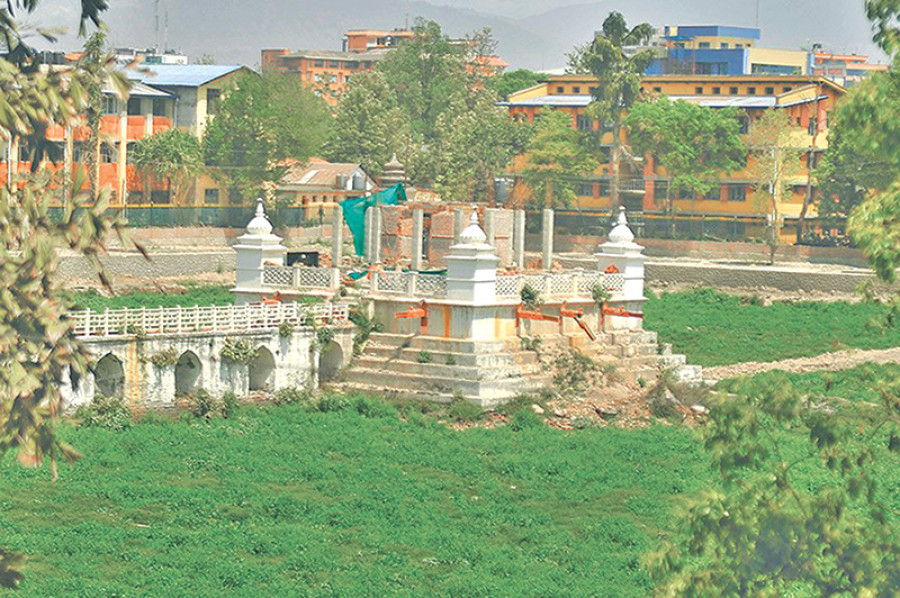Opinion
Bulldozing history
Without our priceless heritage sites, we run the risk of losing our very identity as Nepalis in the long run
Shyam Kc
One of the unpleasant aspects of the past fortnight—apart from the ever present political wrangling—was the ruckus over the so-called modernisation of the centuries old Rani Pokhari. The Rani Pokhari reconstruction that followed the Gorkha earthquake that took the lives of almost 9,000 people was, as one understood, based around the construction of a kind of resort in the middle of the city where the young could go and spend their money and feed the money-hungry. The fact that reconstruction had started long before the local elections that elected the Mayor and the Deputy Mayor point to the fact that the decision to reconstruct the centuries old Rani Pokhari in a modern style was taken by the Kathmandu Metropolitan City (KMC) officials without consulting the local people or ascertaining their views. The local people had protested against the decision but such protest without political backing had no effect on the officials or their political masters. The tendency to neglect and brush aside the wishes and aspirations of the people is nothing new among our leaders and government officials.
Of politics and vested interests
The debate over Rani Pokhari reconstruction would have been lost despite the initial local protests if it had not been for the initiative taken by Ranju Darshana who opposed the modernisation of Rani Pokhari, which would have catered to the unnecessary requirements of passers-by, including tourists. Immediately after Darshana’s vocal opposition, the newly elected Mayor Bidya Sundar Shakya, came in defence of the project, stating that the new construction had the approval of the Department of Archaeology and that it was meant to cater to the needs of the tourists. The project was launched before Shakya took office and the alacrity with which the Mayor justified the project without delving deeper into the issue puzzled many. Was some vested interest at play? Do tourists visiting Nepal have to come to Rani Pokhari to sip a cup of tea or coffee? There are thousands of other such modern areas all around the world—many of them better than what the modernised Rani Pokhari would have been. In any case, the country’s heritage is primarily for the people of this country, they are meant to remind locals of their history. There was also a confrontation between the Mayor and the Deputy Mayor over the issue. The Deputy Mayor was reported to have cried as she was not in a position to do anything to stop the reconstruction. However, following the controversies, the project has now been halted and what shape it will take in the future remains to be seen, though it is being reported that it will be rebuilt in its original shape.
The KMC has in the past indulged in activities that have been far from transparent. The KMC that did not permit construction of buildings in areas surrounding Tundikhel above a certain height allowed massive structures like the Kathmandu Mall to take shape. The building was not permitted to be constructed during the Panchayat era and even after the advent of democracy, the Nepali Congress mayor, PL Singh, did not give the Provident Fund the permit to do so. But with the advent of the next mayor, Keshav Sthapit, things changed and the permit was given with the result that the building was built and the historic Sundhara went dry, as the source of water was blocked because of the extra deep foundation of the Kathmandu Mall. In addition, the Green Zone (Tundikhel) is now surrounded by tall buildings which were not allowed in the past. Unfortunately, Tundikhel itself is no longer green, thanks to “sagacious” decisions taken by concerned authorities. The permission of the KMC is required to build structures including buildings in the city, and one wonders how the local body permitted the Army to build so many structures at the southern end of Tundikhel. (One hopes the Army had the decency to get the necessary permit from the municipality, for law in a democracy applies equally to all including the government and the Army.)
More temples no more
While wishing that the KMC or its officials have no ulterior motive, the decision to construct a skyscraper where once there was a bus depot cannot but be questioned. The building is projected to be a shopping complex. The city is full of shopping malls and hence the decision of the KMC to move the bus depot to a part of the Open Air Theatre (Khula Manch) in Tundikhel, thereby encroaching on the space made for public meetings and depriving the young of playing fields, is hard to understand. Kathmandu was once said to have more temples and shrines than houses but now there might be more shopping complexes and tall apartments than there are typical Nepali buildings in the city. Perhaps, political parties willing, the time has come to review the rationale behind many of the municipality’s decisions that have direct bearing on the people.
The initiative taken by Darshana has no doubt resulted in the present halting of the Rani Pokhari project and could be the beginning of youths taking initiative in the preservation of heritage, not only in the Kathmandu Valley but elsewhere in the country as well. One must salute Ranju Darshana and the likes of her, who, even in their young age, realise the importance of preservation of the country’s heritage for future generations. For without these priceless and irreplaceable heritages, in the long run, we will lose our identity as Nepalis




 9.12°C Kathmandu
9.12°C Kathmandu










